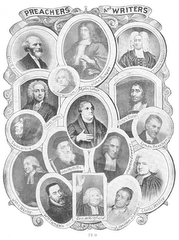Dispensationalism VS Covenant Theology - Part 1
Dispensationalism VS Covenant Theology
The following two posts are the major differences between these two systems of theology. They represent the mainstreams of both systems, though there are variations in each. Representative systematic theologies are those of L.S. Chafer and Charles Hodge. The numbers before each statement match-up and go point for point across the two systems of belief.
COVENANT THEOLOGY
1. Always Calvinist. Usually 5-point.
2. Accepts both literal and figurative interpretation of the Bible.
3. Almost always accepts the idea of The ‘Analogy of Faith.’
4. ‘Israel’ may mean either literal, physical descendants of Jacob or the figurative, spiritual Israel, depending on context.
5. ‘Israel of God’ in Gal. 6:16 means spiritual Israel, parallel to Gal. 3:29; Rom. 2:28029, 9:6; Phil. 3:3.
6. God has always had only 1 people, the Church gradually developed.
7. The Church began in O. T. (Acts 7:38) and reached fulfillment in the N. T.
8. There are many O. T. prophecies of the N. T. Church.
9. Some O. T. prophecies are for literal Israel, others are for spiritual Israel.
10. God’s main purpose in history is Christ and secondarily the Church.
11. The Church is the culmination of God’s saving purpose for the ages.
12. The main heir to Abraham’s covenant and was Christ and spiritual Israel.
13. The eternal Covenant of Redemption was within the Trinity to effect election.
14. God made a conditional Covenant of Works with Adam as representative for all his posterity.
15. God made a Covenant of Grace with Christ and His people, including Adam.
16. Israel was right to accept the Covenant Mt. Sinai.
17. The ‘New Covenant’ of Jer. 31 is the same as in Lk. 22; both are for spiritual Israel according to Heb. 8.
18. God’s program in history is mainly through related covenants.
19. No man has ever been saved by works, but only by grace.
20. All men who have ever been saved have been saved by faith in Christ as their sin-bearer, which has been progressively revealed in every age.
21. O. T. believers believed in the Gospel of Messiah as sin-bearer mainly by the sacrifices as types and prophecies.
22. The Holy Spirit has indwelt believers in all ages, especially in the present N. T. era, and will not be withdrawn.
23. Jesus made only an offer of the spiritual Kingdom, which was rejected by literal Israel but has gradually been accepted by spiritual Israel.
24. Believers in al ages are all ‘in Christ’ and part of the Body and Bride of Christ.
25. The Law has 3 uses: to restrain sin in society, to lead to Christ, and to instruct Christians in godliness. The ceremonial Laws have been abolished; the civil laws have been abolished except for their general equity; the moral laws continue.
26. O. T. laws are still in effect unless abrogated in the N.T.
27. The Church is the Kingdom of God. Covenanters are usually Amillenial, sometimes Pre-Millenial or Post-Millenial, rarely Pre-Tribulational.
28. The O. T. sacrifices were fulfilled and forever abolished in Christ.
29. Christ fulfilled the Covenant to Abraham. Some Covenanters believe in a future forliteral Israel, most don’t.
30. Christ alone sits on the throne. Saints rule under Him.
















3 comments:
Nick, I am meeting more and more 5-Point Calvinist brothers all the time that hold to this position of Covenant Theology. I think this theology is one that should be looked at closely. Good study!
Nick
Are you a Dispy any More?
I leave the closet outing to Jason. =)
Post a Comment